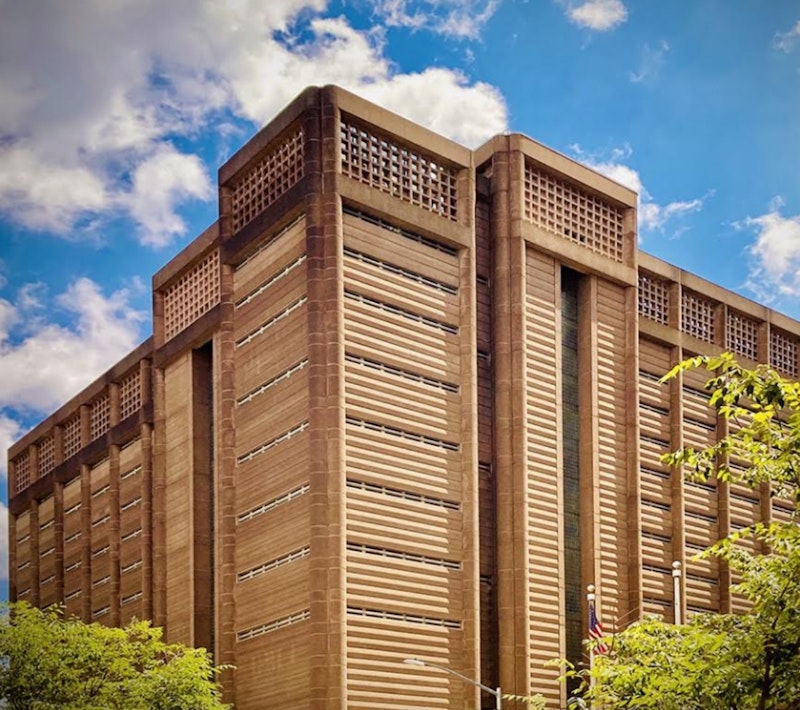As I poured a bowl of cereal, a kitten kept close watch. He stood up and meowed out of curiosity. I offered the young tiger a taste. With a fleeting summer morning afterthought, I pondered whether cereal milk would make a good ice cream flavor.
Suddenly summer is here; scarves, coats, and hats disappear for another season. Temps are up and the clothes are off. An instant flesh display hits the streets with exposed midriffs, legs, and tattoos. The fragrance of an entire Sephora perfume line fills an elevator at any given moment on hot days. Pass by a bakery and there’re more street scents. Not all smells are pleasant: the top pungent offenders: human, garbage and rodent odors. It’s a fact: New Yorkers complain about everything all the time.
Next block, another thing to despise: a detour being redirected by a film shoot person. Don’t act up, you might end up in jail. However, that’s not possible in New York City these days. The jail is closed.
The former temporary residence of those held pending trial is currently undergoing demolition. The 1983 construction known as “The Tombs,” the Manhattan Detention Complex on White and Centre St. is a particularly unattractive Brutalist building. For years, families, friends and lawyers waited outside in line to visit the incarcerated; they certainly won’t miss it, so you probably won’t either.
The new 30-story correctional facility will be big; so big it’ll become the world’s tallest jail scheduled to open in 2027. The heavy price tag isn’t without controversy. The development decision didn’t go down well with the bordering neighborhood, historical Chinatown.
Since 1838 in downtown Manhattan, there’ve been four jails with dark histories located in the same spot. So many things went wrong with first 19th-century jail, including the brilliant idea to use hemlock logs to fill in the Collect Pond marshland, the building eventually sunk. Beyond the jail’s baleful entrance, gallows were set up under “The Bridge of Sighs” in a death row courtyard where over 50 convicted murderers were hung. This area was once the notorious, ramshackle slum called Five Points.
In 1902, a second jail was built. Then in November 1926, five died; three inmates and two wardens killed in an uprising. In August 1970, the third “Tombs” had an 800-person riot.
There was a fierce, three-year battle against this jail’s demolition and construction. Directly across the street, the wooden shacks alongside Baxter St. restaurants serve as a reminder of a pandemic’s after-effects—yet another challenge for an already racially and economically traumatized community.
Dysphoria related to historical buildings is becoming more common. The character of Chinatown is being erased by a previous administration’s decision. Hardships continue to gnaw at the fabric of the neighborhood. There’s no denying; residents and businesses felt ignored. It’s a sad result considering the previous mayor’s “head in the sand” stubbornness, despite widespread public outcry overrebuilding the jail.
Speculation suggests the growth will have an impact on the stunning dark olive, Art Deco marble facade of the Criminal and Supreme Courts. Many films, television shows, and nightly news stories used these iconic towers, including the 1947 noir classic Kiss of Death, a Shaft remake, numerous Kojak episodes, and it’s home to Harvey Weinstein’s tennis ball, Walker of Shame. City officials remain mute as demolition work proceeds.
Further uptown in the heart of Chelsea, an entire block disappeared. On the corner of 23rd St. and 8th Ave., a CVS pharmacy, a Gap store and a gym are gone. Didn’t take a leave of absence, didn’t say good-bye—Poof!—just disappeared at lightning speed.
Is this what New Yorkers really want to see, another glass and steel building? The earthquake-level construction booms can be heard echoing blocks away. Debris from demolition is ground to dust by garbage trucks while workers pound steel. Epic noise never seems to stop. The shaking sends reverberations into the subway tunnel. Cement trucks come and go all day long. A tiny flame becomes a three-alarm fire with a wail of sirens in the distance.
Like clockwork, New York City building owners take advantage of the perfect weather to undergo Local Law 11 outside repair work. The law states: buildings taller than six stories require a facade inspection every five years to make sure exteriors are safe. Block after block, residential and commercial properties are covered sidewalk to sky, obscured in scaffolding.
A foreboding expression is written on the faces of terrified pedestrians having a mental crisis as they ready themselves to walk through another gauntlet of fear—plywood, ladders, wires, nets and chains takeup every inch of sidewalk space. Foot traffic is left to fend on its own. If you happen to be hiding out under some scaffolding before going work in the morning, there’s always a chance someone outside about 50 feet away from a building’s entrance is on a smoke break. They’ll take two puffs, followed by three chokes, a wheeze topped off by a throat clearing, followed by chronic, emphysema-like trouble breathing. Maybe try give up smoking.
On any given day, the sun is obscured by various degrees of smoke, air pollution, and building power-wash overspray. A cannabis cloud moseys up the street blending with a larger tobacco cloud. Wake and bakers, you’ll need extra time to get to your work cubicle or desk to go through security. Hope the AC is working today.
Then it occurred to me, wouldn’t it be nice listening to a timeless Beach Boys tune on a warm summer day. The hit song “Cruel Summer” by Bananarama gets me going. I’m reminded of the carefree London trio prancing down New York City streets on a cokebuzz at the height of MTV 1980s music videos. The girls attempt car maintenance, scale a fire escape, and use pay phones while being pursued by a Mack truck-driving Dukes of Hazard dude. What’s not to like about a dance party that follows eating bananas and throwing used peels on a NYPD car windshield. Summer’s here.

